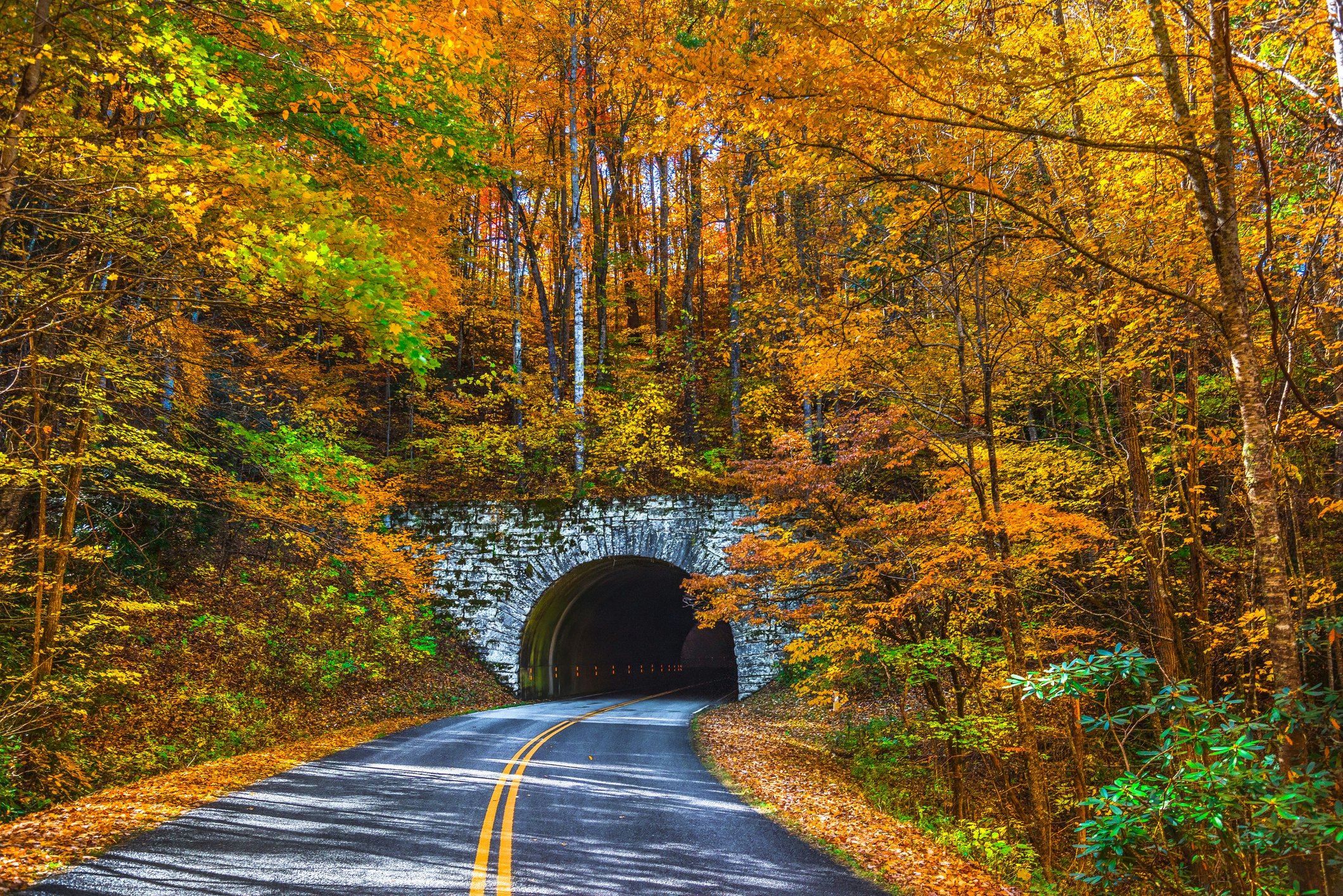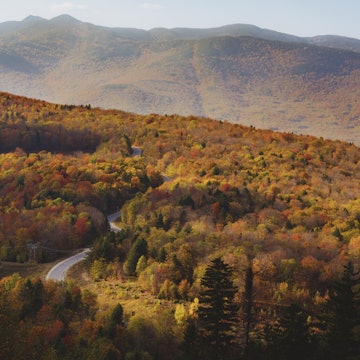
The best times to visit Asheville: a year-round guide to what's happening in "Beer City"
May 26, 2022 • 8 min read

From live music events to seeing flowers in bloom, here's what's happening through the year in Asheville © Fotoluminate LLC / Shutterstock
Between Asheville's splendid natural setting in the southern Appalachians and its funky, artsy culture rich in both hand-thrown pottery and hand-crafted beers, it's no wonder that Asheville is visited by eleven million travelers each year. But perched 2134ft up in the Appalachian Mountains, it's important to find the best time to visit – whether you're hoping to take advantage of outdoor activities like the Blue Ridge Mountains and Pisgah National Forest, or more indoorsy fare like the Biltmore Estate and River Arts District.
The best time to visit Asheville is going to be different for each traveler depending on their preferences about weather, budget, and “must-see” activities. We've got the the low-down on this high-up town – whether you're seeking fall foliage, winter skiing, or eclectic culture any time of year.

High season is October, the best time to see autumn foliage
October is the peak for fall's changing leaves, so it’s also Asheville’s peak tourism season. Leaves are typically at their brightest in the last half of the month. Plan ahead for a visit during this period, as hotel rooms tend to book up early, and rates can be double what you’d expect to pay in quieter periods. The stunning natural views and temperate weather are often worth the expense.
Leaf seekers can find the best colors when they drive down the Blue Ridge Parkway, which provides incredible views of the eponymous mountains all year long. The mountains’ oak trees release a chemical, isoprene, which creates the illusion that the peaks and hillsides are blue. During foliage season, the red and orange leaves contrast against this phenomenon, creating the perfect conditions for photo-snappers.
If you’re up for a hike, the leaves are especially vivid at higher elevations. Keep in mind, though, that they change color more quickly in these conditions and timing your trip to see them can be tricky. The trees at Looking Glass Rock or Lookout Mountain, for example, may be at their peak a week before the trees change in Asheville’s city limits.
For less strenuous viewing, you can always enjoy the trees in Asheville’s municipal parks and trails, too, not to mention historic Riverside Cemetery.
Shoulder season (March to April, July to August) is a great time to see things in bloom
The spring and summer months are some of the most beautiful that Asheville has to offer. In spring, cherry and pear trees begin to bloom. In summer, rhododendrons, azaleas, and mountain laurel pop up in the mountains.
Visitors who want to see the seasonal bloom can check out the Lake Lure Flowering Bridge. In 2013, community members upcycled a historic bridge into a planned garden. Now, it’s covered in flowers that both pollinators and humans can appreciate.
During July and August, beat the heat with kayaking or fishing. The water in the French Broad River remains cool for much of the summer and is a local favorite for swimming. April is the best time for trout, and you’ll spot anglers during this period.
Summer is also concert season in Asheville. Among its biggest events is the Mountain Dance and Folk Festival. Festival entertainment includes storytelling, clogging, and bluegrass music.

Low season is November to January and is the best time to ski
Some tourists avoid Asheville in the winter months because the narrow mountain roads can be hard to navigate in snow or ice. Skiers, on the other hand, can take advantage of affordable hotel rates and abundant snowfall.
Within two hours of Asheville you can experience firsthand why they call it the High Country with some of the tallest slopes on the east coast, where skiers can take their pick from several resorts. Beech Mountain Resort has the distinction of sitting over a mile high – the greatest elevation of any town in the eastern US. The resort is over 50 years old, and there are runs for every skill level.
Sugar Mountain Resort is the largest in North Carolina, with 21 trails (including a double black diamond) and 9 lifts, topping off just short of Beech Mountain's elevation at 5300 feet. Just under an hour from Asheville is the Cataloochee Ski Area in Maggie Valley, while Wolf Ridge promises plenty of powder fit for beginners and intermediate skiers.
All the local resorts offer chill extras like snow tubing and steamy cocoa for any non-skiers, and if that hot chocolate sounds good, check out the late-January Hot Chocolate Races and Marshmallow Dash back in town. The proceeds benefit local causes, and the reward comes courtesy of local chocolatier French Broad Chocolates.
Another fun winter activity is to play observer to quirky mountain rituals like the Sapphire Valley Ski Resort's unique outhouse race, where participants build and decorate an outhouse on skis and send it down the slopes with a passenger. Check ahead for timing; the outhouse race tends to mark the end of ski season, which can vary month to month each year.
Score some hand-knitted mittens from the Folk Art Center before heading out to see the holiday light display at the Biltmore Estate and the state arboretum.
January is Asheville's snowiest month
Attention to all the snow bunnies who aren’t intimidated by chilly weather: January is the snowiest month in Asheville, and temperatures average in the 30ºFs (-1–3ºC). Perhaps that’s why this month is one of Asheville’s least busy for tourism. But visitors can swap cabin fever for a warm cider at the Funkatorium or some artisan hot chocolate.
Key events: MLK Prayer Breakfast and March, Asheville’s Hot Chocolate Races.
Visitor numbers start to increase in February
By February, the temperatures don’t pick up – but tourism does. Asheville attracts local visitors to celebrate Valentine’s Day by sharing wine and a book at the Battery Park Book Exchange & Champagne Bar. Toward the end of the month, families attend the annual Asheville Train Show, which brings together over 200 vendors and loads of model trains.
Key events: Asheville Train Show, Mardi Gras Parade.

March in "Beer City" is lively with events at local breweries
March Madness hits Asheville hard, especially with the state’s notorious Duke vs Chapel Hill basketball feud. Between college basketball and St. Patrick’s Day, this month is a great time to tour the area’s pubs and bars. With one of the largest collections of breweries per capita anywhere in the United States, beating out even other famous beer cities like Boulder and Bend and trailing behind only Portland, Maine, you'll understand why Asheville’s nicknamed “Beer City”.
Key events: St. Patrick’s Day events at local breweries.
April brings rain showers and spring flowers
Temperatures average in the pleasant 50ºFs (10–15ºC) – ideal for a nature walk and to photograph the blooming bushes and trees. Just don’t forget a rain jacket; April is the second-rainiest month in Asheville. Learn about wildflowers and herbs at the annual herb festival, which has drawn herbalists and gardeners since the 1990s.
Key event: Asheville Herb Festival (late April/early May).
May is slightly warmer and a bit busier
Temps rise to the 60ºFs (15–20ºC). Visitors come to Asheville in May to birdwatch and tour the countless flowers in bloom at the Biltmore Estate, which remains America’s largest private residence.
Key events: Biltmore Blooms, LEAF cultural and music retreat, Asheville Beer Week.
Pride celebrations run through June
Asheville’s June activities may attract more locals than visitors. During Pride month, guests can get a taste for Asheville’s LGBTIQ+ scene by visiting North Carolina’s longest-standing gay bar, O. Henry’s.
Key events: Pride celebrations, Black Mountain Art By the Tracks.

July is a good time to hike in the Appalachians
The summer months can provide the perfect time and weather to hike the Appalachian paths and spot wildlife. This town can get hot in this season, with temperatures in the 80ºFs (26–31ºC). But rain showers and a mountain breeze help tamp down the heat.
Key events: Biltmore concert series (not running in 2022), Craft Fair of the Southern Highlands.
There are outdoor concerts in August
Music lovers, rejoice. In August, the spring rains peter out to the balmy, sunny days of summer. Attend an outdoor concert or learn a line dance at the Mountain Dance and Folk Festival.
Key events: Biltmore concert series (not running in 2022), Mountain Dance and Folk Festival.
September is time to harvest apples
In September, many North Carolinians are harvesting an important local crop: apples. September travelers can visit the state apple festival and local orchards to pick the last of the season’s fruit, nibble on homemade apple dumplings, and sip on apple cider.
Key events: Goombay Festival, North Carolina Apple Festival.

It's busy in October when the fall foliage is at its best
October is the most popular time to visit Asheville. Hotel and cabin prices increase as tourists admire autumn foliage from scenic overlooks. While the cost of finding lodging during peak season may pinch a traveler’s pocketbook, people can climb mountain peaks and spot the prettiest leaves for free.
Key events: VeganFest, Craft Fair of the Southern Highlands.
November is a quiet time to visit
November is Asheville’s least busy month, so it’s an ideal time to beat the crowds and grab great deals on hotels.
Key events: Christmas at Biltmore, holiday light climbs at the Adventure Center of Asheville.
See the Christmas lights during December
The twinkling lights at the Biltmore Estate are a must-see winter attraction. Before the holidays, Biltmore staff string thousands of lights throughout the house. A visitor may feel like they’ve traveled back in time to Christmas Eve of 1895, when the Vanderbilt family first invited their loved ones into the home.
Key events: Christmas at Biltmore, winter lights at the North Carolina Arboretum, National Gingerbread House Competition, Ugly Sweater Crawl.















